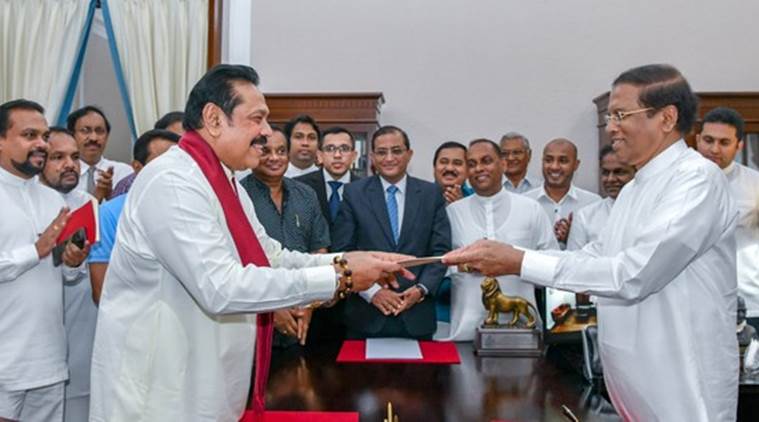
Sudden regime change in Sri Lanka: Mahinda Rajapakse is back, now as PM
Sri Lanka was in turmoil Friday after former President Mahinda Rajapakse made a stunning return to power as the country’s new Prime Minister. He was sworn in by President Maithripala Sirisena who fired Prime Minister Ranil Wickremesinghe. But Wickremesinghe called the move “illegal and unconstitutional” and said he was still the Prime Minister and would prove his majority.
The dramatic developments in Colombo followed a breakdown in ties between Sirisena and Wickremesinghe, especially on policy issues related to economy and security. Sirisena’s United People’s Freedom Alliance announced it was leaving the National Unity Government with Wickremesinghe’s United National Party.
The government had been tottering ever since Rajapakse’s party emerged victorious in local elections earlier this year. Multiple sources said Wickremesinghe was in Galle when Sirisena and Rajapakse moved in Colombo.
However, questions about the constitutionality of Sirisena’s actions swirled. Wickremesinghe was quoted by Sri Lanka’s Daily Mirror website saying “I am still the Prime Minister of this country”, while his Finance Minister Mangala Samaraweera tweeted that what had taken place was “illegal”, “unconstitutional” and an “anti-democratic coup”.
Under the 19th Amendment of the Sri Lankan Constitution, brought in by the National Unity government in 2015, and which restricted many of the President’s powers, he also lost the power to dismiss the Prime Minister.
The Amendment specifies that a Prime Minister cannot be removed unless he resigns from office, or ceases to be a Member of Parliament. The resignation of the Prime Minister can also lead to dissolution of Parliament.
Under Article 42 (4) of the Constitution, “The President shall appoint as Prime Minister the Member of Parliament, who, in the President’s opinion, is most likely to command the confidence of Parliament.”
But under Article 46 (2), “The Prime Minister shall continue to hold office throughout the period during which the Cabinet of Ministers continues to function under the provisions of the Constitution unless he resigns his office by a writing under his hand addressed to the President; or ceases to be a Member of Parliament.”
It remained unclear if, and how, the United National Party was preparing to fight back. Much will rest on Sri Lanka’s recently appointed Chief Justice Nalin Perera.
Under the 19th Amendment, Rajapakse, who has already served twice as President, cannot run again for the office. However, as Prime Minister, he would be in a better position than he was sitting out on the bench, to ensure his candidate for the presidency wins. Or, if the new dispensation decides to call an early election, Rajapakse may place his bets on making enough numbers to change the Constitution again so that he gets another shot at the presidency.
Kusal Perera, a political analyst in Colombo, said Rajapakse will work on getting two-thirds majority in Parliament. “According to the 19th Amendment, a resolution adopted by two-thirds majority can dissolve Parliament. So we will be expecting Parliament election early 2019. My observation is that Mahinda expects two-thirds majority in the election to go for a constitutional amendment thereafter,” he said.
For Wickremesinghe, this is second time unlucky. In an earlier “co-habitation” government with the SLFP whose term began in 2001, he was dismissed in 2004 as Prime Minister by President Chandrika Kumaratunga.
On Friday evening, legal questions appeared to have been brushed aside, at least for the moment, as Rajapakse was sworn in, bringing to an end a cat-and-mouse game between him, Sirisena and Wickremesinghe that began when Rajapakse lost the presidential election to Sirisena.
It came to a head after the sweeping victory of the Rajapakse-backed Sri Lanka Podujana Peramuna (SLPP) — essentially a repackaged faction of the SFLP that had remained loyal to the former President — in the local elections.
That was the beginning of the end of the NUG, with Sirisena, who is the leader of the SLFP-led Sirisena’s United People’s Freedom Alliance, and Wickremesinghe, the leader of the United National Party, drifting irreconcilably apart.
India, whose relations with Rajapakse had snapped almost entirely before the 2014 presidential election, mainly for his open and almost deliberately provocative embrace of China through his second term as President, watched the drift with worry, but was unable to bring about a patch-up.
New Delhi is said to have backed Sirisena’s candidature in 2014 and sees Wickremesinghe as the most India-friendly of the political leaders in Sri Lanka. But it has also reached out to Rajapakse. Prime Minister Narendra Modi met him on his visit to Sri Lanka last year, and in August, Rajapakse met Modi during a visit to India.
On Friday night, official sources in New Delhi said they were aware of the developments and were monitoring the situation closely. The sources said Wickremesinghe, who was in New Delhi last Saturday, did not mention about the political situation during delegation-level talks with the Indian side. “We will have to get a sense of the situation from our mission in Colombo,” sources said.
— With ENS, New Delhi

Comments are closed.